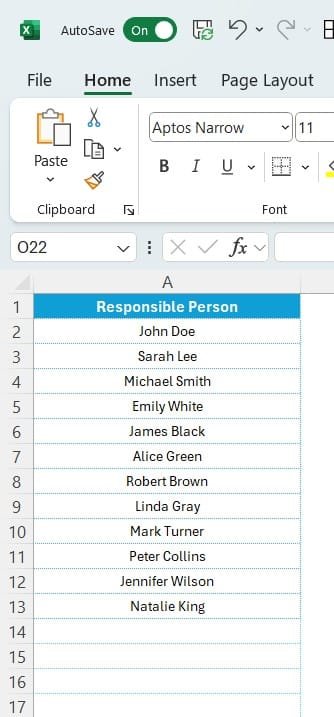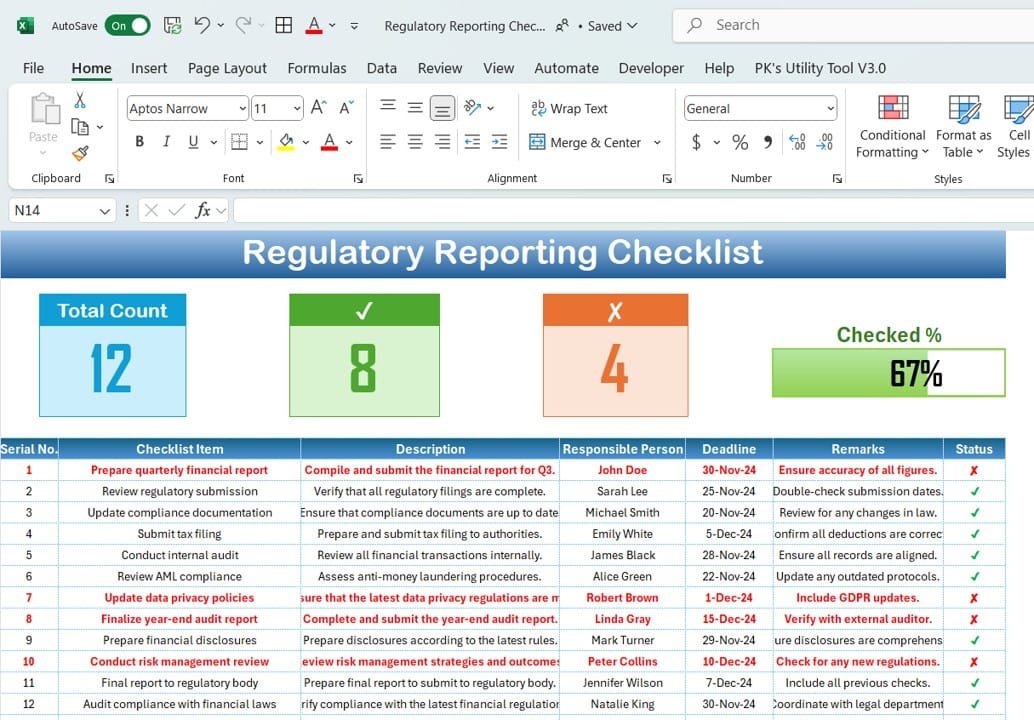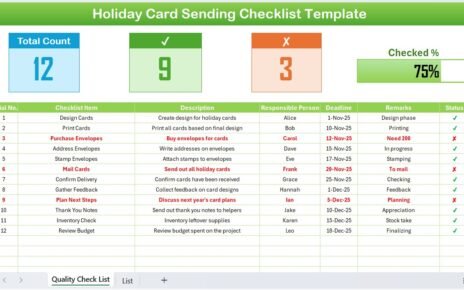a In today’s fast-paced and regulated business environment, staying compliant with industry standards is essential. Regulatory reporting is not just about following the rules; it’s about ensuring that everything is done correctly and on time. This is where a Regulatory Reporting Checklist becomes invaluable. It’s a powerful tool that helps organizations manage, track, and complete regulatory tasks while maintaining high standards of accuracy and compliance.
In this article, we will take a deep dive into the Regulatory Reporting Checklist, explain why it’s important, walk you through its key features, and discuss best practices. Additionally, we will explore the opportunities for improvement in regulatory reporting and address some of the most frequently asked questions.
Click to Regulatory Reporting
What Exactly is a Regulatory Reporting Checklist?
A Regulatory Reporting Checklist is essentially a document or template that organizations use to track the various tasks related to regulatory compliance. It helps in managing the various reporting requirements, ensuring that all actions are taken on time, and that nothing is overlooked. By providing clear guidance on what needs to be done and when, the checklist is an indispensable tool for any compliance team.
Why is it so Crucial?
The importance of regulatory reporting cannot be overstated. Non-compliance or missed deadlines can result in severe consequences, including hefty fines, legal issues, or even damage to a company’s reputation. With a checklist in place, you can:
- Ensure Accuracy: Keep everything in check and ensure that reports are accurate and meet legal requirements.
- Track Deadlines: Stay on top of strict deadlines and avoid penalties for late submissions.
- Improve Accountability: Assign specific individuals to tasks, making everyone responsible for their part.
- Monitor Progress: Keep track of each task’s progress to ensure that nothing falls through the cracks.
Key Features of the Regulatory Reporting Checklist Template
The Regulatory Reporting Checklist template is designed to make regulatory reporting as simple and efficient as possible. With its structured approach, the template helps you manage each task from start to finish.
Worksheets in the Template
The template includes two main worksheets:
- Regulatory Reporting Checklist Worksheet: This is where the core of the checklist is captured. It contains all the tasks, deadlines, responsible individuals, and the progress of each task.
- List Worksheet: This sheet includes a list of responsible persons, which allows you to create a drop-down menu in the main checklist to easily assign tasks.

Click to Regulatory Reporting
Progress Tracking Cards
At the top of the Regulatory Reporting Checklist Worksheet, there are three key progress cards that help you monitor the overall status of your reporting process:
- Total Count: Displays the total number of tasks listed in the checklist.
- Checked Count: Shows how many tasks have been completed.
- Crossed Count: Displays how many tasks have not been completed or marked as crossed off.
- Progress Bar: A visual tool that shows the percentage of tasks that have been completed.
These cards are crucial for tracking your progress and ensuring that everything is on schedule.
Checklist Table
The main table in the worksheet includes the following columns:
- Update Task Status: You can easily update each task’s status, marking it as completed (✔) or not completed (✘).
- Assign Responsibilities: With the drop-down menu from the List Worksheet, you can quickly assign the right person to each task.
- Set Deadlines: Each task has its own deadline, ensuring timely completion.

Click to Regulatory Reporting
Advantages of Using a Regulatory Reporting Checklist
Implementing a Regulatory Reporting Checklist in your organization offers numerous benefits. Let’s take a closer look at the main advantages:
- Ensures Compliance: First and foremost, the checklist helps ensure that all regulatory tasks are completed in accordance with the required guidelines. By following the checklist, your company can stay compliant and avoid any potential legal issues.
- Promotes Accountability: Every task in the checklist is assigned to a specific person or team. This promotes accountability and helps ensure that all team members know exactly what their responsibilities are.
- Helps Prevent Penalties: Meeting deadlines is critical in regulatory reporting. A missed deadline can result in fines or other penalties. The checklist helps you stay on top of deadlines and ensures all tasks are completed on time.
- Improves Communication: The checklist fosters better communication between departments. When everyone knows what’s expected of them and when tasks are due, it becomes easier to collaborate and keep everyone aligned.
- Provides Progress Visibility: With the checklist’s progress tracking features, you can see at a glance how far along the reporting process is. This allows you to quickly identify any tasks that need attention and ensures everything is progressing smoothly.
Opportunity for Improvement in Regulatory Reporting
While the Regulatory Reporting Checklist is a powerful tool, there’s always room for improvement. Here are some opportunities that can help enhance your reporting process:
- Automation of Tasks: To reduce the time spent on manual updates, consider automating the checklist with software that tracks progress and updates statuses in real-time. Automation can make the process more efficient and error-free.
- Collaboration in Real-Time: Cloud-based tools enable multiple team members to work on the checklist at the same time. Real-time collaboration ensures that all updates are instantly visible to everyone, keeping everyone on the same page.
- Keeping Up with Regulatory Changes: Regulatory rules often change. To stay compliant, it’s important to keep the checklist up to date. Regularly review and adjust your checklist to incorporate any new regulatory requirements.
- Customizing the Checklist: Every organization’s needs may differ slightly. Therefore, it’s a good idea to customize the checklist to fit your specific requirements. You can add new columns, modify the layout, or add more detailed descriptions as needed.
Best Practices for Using a Regulatory Reporting Checklist
To make the most of your Regulatory Reporting Checklist, follow these best practices:
- Regularly Update the Checklist: Your checklist needs to be updated frequently to stay relevant. As new tasks arise or deadlines change, update the checklist to reflect the current status of all reporting obligations.
- Set Realistic Deadlines: Deadlines should be realistic and achievable. Setting too tight of a deadline can lead to mistakes, while overly lenient deadlines may delay progress. Aim for deadlines that are both realistic and challenging.
- Clarify Responsibilities: Make sure every task is assigned to a specific person. This ensures there’s no confusion over who is responsible for what, and it helps avoid tasks being overlooked.
- Track Progress: Don’t just set the checklist and forget it. Track the progress regularly and update statuses. This will allow you to catch any issues early and keep everything moving forward.
- Focus on Quality Control: Quality control is essential. Make sure that every task is completed to a high standard before marking it as done. The checklist should serve as a guide to ensuring that the final regulatory report meets all compliance requirements.
Conclusion
A Regulatory Reporting Checklist is an essential tool for organizations that want to stay compliant with industry regulations. By using this checklist, you can manage your regulatory tasks effectively, ensure timely submission of reports, and keep track of all important deadlines. Moreover, with its built-in tracking system and clear assignment of responsibilities, it helps improve efficiency and accountability across your team.
While the checklist is a great tool, always look for ways to improve the process. Automating, collaborating in real-time, and keeping the checklist up-to-date are all effective ways to ensure that your regulatory reporting remains accurate, efficient, and compliant.
Frequently Asked Questions (FAQ) About the Regulatory Reporting Checklist
- What is a Regulatory Reporting Checklist?
A Regulatory Reporting Checklist is a document used to track and manage regulatory tasks. It includes all the necessary details, such as the task descriptions, responsible individuals, deadlines, and progress tracking.
- Why is a Regulatory Reporting Checklist Important?
This checklist is crucial because it helps ensure that your organization remains compliant with regulatory requirements. It also helps prevent missing deadlines, reduce errors, and improve communication among team members.
- How Can a Checklist Improve Regulatory Reporting?
By providing a structured approach, a checklist ensures all regulatory tasks are completed on time and accurately. It helps you track progress, assign tasks, and ensure everything is in order before submission.
- Can I Customize My Regulatory Reporting Checklist?
Yes, you can customize the checklist to meet your organization’s specific needs. You can adjust columns, add new sections, and tailor the template to suit your reporting requirements.
- What Should I Include in a Regulatory Reporting Checklist?
A good checklist should include tasks, descriptions, assigned individuals, deadlines, progress tracking, and remarks. It should also have a clear structure to ensure that all tasks are completed efficiently and on time.
Visit our YouTube channel to learn step-by-step video tutorials
View this post on Instagram
Click to Regulatory Reporting



